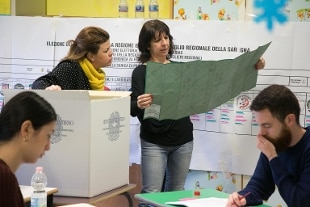Stock image
Elections, 15 million masks and 315 thousand liters of gel to ensure safety in the polling stations
Elections: Viminale, guide to anti Covid measures
Share
19 September 2020After the last elections, silence fell - from midnight on Saturday 19 September - in view of the vote in the referendum and in the regional ones. On 20 and 21 September, in fact, Italians are called to vote for the referendum on the cut of parliamentarians. In addition, regional elections will be held in Campania, Tuscany, Veneto, Liguria, Marche, Puglia and Valle d'Aosta. But also the administrative ones in 962 Municipalities and the supplementary ones in Sardinia and Veneto.
How to vote
Voting takes place over two days: Sunday 20 September and Monday 21. The polling stations are open from 7 to 23 on Sunday and from 7 to 15 on Monday. There are 46,641,856 voters called to express themselves for the constitutional referendum and 18,473,922 those for the regional elections, involving 6 Regions with ordinary statute (Campania, Liguria, Marche, Puglia, Tuscany and Veneto) and 1 with special statute (Valle d'Aosta). For the supplementary elections of the Senate of the Republic, those entitled to vote are 467,122 for Sardinia (plurinominal college 01 - uninominal college 03 Sassari) and 352,696 for the Veneto (plurinominal college 02 - uninominal college 09 Villafranca di Verona).
The administrative elections, on the other hand, affect 962 municipalities and involve 5,725,734 voters. The municipalities include several provincial capitals, including Aosta, Arezzo, Bolzano, Chieti, Crotone, Fermo, Lecco, Macerata, Mantua, Matera, Nuoro, Reggio Calabria, Trani, Trento and Venice, of which three are also regional capitals . For five new municipalities will be voted for the first time. These are Borgo d'Anaunia, Novella, San Michele all'Adige and Ville di Fiemme in the autonomous province of Trento and the new municipality of Presicce-Acquarica in the province of Lecce. The municipality of Marcetelli, in the province of Rieti, is the one with the lowest number of voters, only 74, while Venice, with its 200,700 voters, is the largest.
The question printed on the referendum card is: "Approve the text of the constitutional law concerning 'Amendments to articles 56, 57 and 59 of the Constitution regarding the reduction of the number of parliamentarians', approved by Parliament and published in the Official Gazette of the Italian Republic no. 240 of 12 October 2019? ". The voter will have to tick the Yes box if he wants to confirm the constitutional reform that reduces parliamentarians from the current 945 to a total of 600 (400 deputies and 200 senators), while he will have to put a sign on the No if he does not want the reform to come into force. No quorum is required for the validity of the constitutional referendum: the referendum outcome is in any case valid regardless of the percentage of voters' participation.
Staggered
ballots The ballots will be 'staggered': the first ballots to be scrutinized are those of by-elections, whose counting will begin on Monday immediately after the polls close. It continues with the scrutiny of the constitutional referendum and subsequently, without interruption, the scrutiny of the Regionals will be held. The scrutiny of the municipal authorities, however, is postponed from 9 am on Tuesday.
Anti Covid measures
Obligation to
wear
a mask for all voters who go to the polls; disinfectant gel at the entrance and inside the seat; differentiated paths; no to measuring the temperature, but the voter who is positive, in quarantine or in home isolation must notify the municipality to express the right to vote at home, in total safety. Those of 20 and 21 September will be the first elections, referendums and administrative in some cases, in the era of Covid. There are numerous measures that will have to be implemented to combine the right to vote and the right to health.
Compulsory masks
Voters who go to the polls, the polling chairman and all members of the polling station are required to wear masks during the voting exercise. In particular, the seat members are asked to replace the masks every 4-5 hours if surgical, every 8-10 hours if Ffp2. The prefectures will deliver the personal protective equipment provided free of charge by the Extraordinary Commissioner for the Covid-19 Emergency, Domenico Arcuri and destined for over 60 thousand seats. 15.1 million surgical masks will be distributed. Spacing
, gels and cleaning environments.
The seats must have different entry and exit routes, signs to indicate the route and to ensure the spacing of at least one meter. The cabins must be spaced. Also delivered 315,000 liters of sanitizing gel, used to protect citizens who go to vote, the components of the polling station and the operators involved. The gels must be placed inside the schools used for voting and inside each polling station. The voter is invited to sanitize their hands before and after the vote. Good ventilation of the environment and sanitation of surfaces and booths are required during the two voting days and between one day and the next. The copying pencils themselves must be sanitized between one voter and another. The use of gloves for the chairman and for tellers is recommended. The delivery of 3.4 million gloves to the polling stations is expected.

